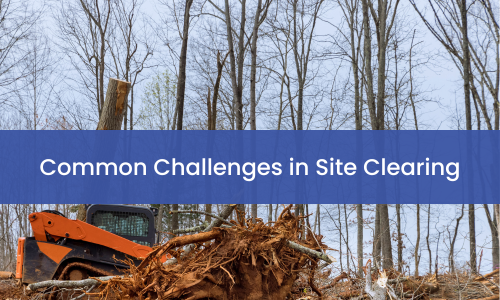Some of the most common challenges in site clearing include:
- Unstable soil conditions
- Site access and heavy traffic
- Proximity to nearby buildings
- Dense vegetation
- Existing structures
- Underground utility lines
- The scale of the project
Because these are common obstacles, experienced site prep teams are well equipped to identify and mitigate them. Hiring a professional contractor ensures the project stays on target with its budget and timeline.
How Expert Site Prep Teams Resolve Common Challenges in Site Clearing
Experienced site clearing companies have seen it all and are therefore prepared for it all. Depending on the job, this may include facing and overcoming the following:
- Unstable soil conditions – One of the most common challenges for site clearing companies in Houston is the soil. Houston’s proximity to the coast means the city is built on a bed of shifting, clay-rich dirt, also known as black soils.
Houston’s black soils pose a major challenge for site clearing and site preparation companies, due to their elevated potential to shrink and swell. Clay-rich soils are a bigger problem during grading and when setting foundations, but they can be difficult to deal with during the site clearing phase as well. If the site is hit with a round of wet weather, for example, it will destabilize the site and make it difficult for heavy machinery to operate.
As dirt work also involves a degree of erosion control, unstable soil conditions can make it more difficult to protect the property’s topsoil.
Site clearing experts mitigate the effects of unstable soils by first analyzing the dirt to determine its load-bearing characteristics. This information will be important during future site prep processes, as the dirt work team will target areas for stabilization via mechanical or chemical methods.
- Difficult site access and the presence of heavy traffic – As a dense, active urban center, Houstonians are constantly dealing with heavy vehicle traffic. This can also be a challenge for site clearing teams who have to mobilize bulldozers, extractors and, potentially, demolition equipment. If heavy traffic is expected around the work site, the site clearing company will identify the safest routes onto the property and establish access. Additional safety measures will be set up, such as fencing off the area and blocking off unsafe roads adjacent to the site, if necessary.
- Proximity to nearby buildings – Many site clearing jobs are close to other buildings in Houston. That means one of the most common site clearing challenges in Houston is managing noise, vibrations and dust for any neighboring buildings.
A site clearing expert will actively communicate and work with the property’s neighbors to minimize the impact of any disturbances. Site clearing companies also have access to noise and vibration-dampening equipment that can keep the disturbance level down.
- Dense vegetation – Dense vegetation is probably the most common challenge for site clearing companies to contend with. This vegetation typically includes trees, shrubs, grasses and their root systems.
When vegetation is dense enough to interfere with construction, it must be removed. To ensure nothing grows back, site clearing teams will use a “grubbing” process to pull the root systems out of the ground with the vegetation. This is a much more thorough approach to eliminating dense vegetation and ensuring it stays gone.
- Existing, dilapidated structures – If the site clearing team discovers existing structures on (or under) the project site, demolition equipment and methods will be necessary. Not all site clearing companies have the expertise and resources to manage demolition, but some do, and it is advantageous to work with a site clearing company that does.
Demolition is done with extractors, bulldozers and specialized demolition machinery like dismantling equipment. Your site clearing company will also need a fleet of trucks to haul off any debris. And if there are hazardous materials present, site clearing personnel will need the appropriate safety equipment and disposal practices.
- Underground utility lines – Any underground utility lines should be identified during the site planning and site survey phases. If utility lines are present, they are marked out on the site’s plans. However, oversights happen and there is always a risk that the site clearing team will encounter an underground utility line while working the site over.
Free utility line services do not detect every type of utility line, and they only work in isolated areas. Site clearing experts have more sophisticated technology for identifying underground utility lines, so they are more reliable at finding those hidden gas, electric or water lines.
- The size and scale of the project – Large-scale commercial projects should be managed by proven commercial site prep teams. If the job is too big or too complex for a less experienced crew, delays and mistakes will happen. Both scenarios are a significant drain for property owners.
Expert site clearing teams know what resources will be needed to complete the job on time and on budget, and if the job calls for additional manpower and machinery, they will have access to those resources.
Expert Contractors Can Overcome Common Site Clearing Challenges with Ease
Common site clearing challenges include the expected dense vegetation, possible existing structures, to the less expected challenges like underground utility lines. Your site clearing partner must be prepared for any of these potential scenarios because they have the potential to delay your project.
Reputable site clearing companies know how to mitigate common site clearing challenges, whether it is with additional equipment, better organization or proactive communication. That is what professionalism means in the site clearing and site preparation industry, and why it is important to work with a reputable contractor to manage your project.
- Common Challenges in Site Clearing - April 15, 2025
- Common Causes of Asphalt Cracks - April 11, 2025
- Seven Signs of a Failing Parking Lot - April 2, 2025

